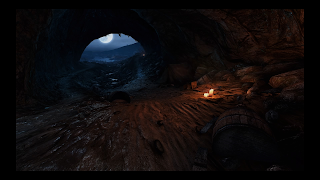Dear Esther Review: Leave Only Footprints...
A visitor arrives on an abandoned Hebridean island. They reminisce while exploring the ruins of the island's past inhabitants.
Ghostly figures haunt the cliffs and shores.
The entirety of the game is spent treading a linear path through the beautiful, yet hauntingly dark island while listening to an anonymous narrator read a series of letters sent to his deceased wife, Esther. As the player explores the remains of derelict buildings, shipwrecks, and signs of tragedy on the island it becomes apparent that there are surprisingly few objects to interact with. The player is simply meant to walk, observe, and listen. The environment oozes with melancholic vibes and its initial beautiful appearance is easily marred upon further inspection. Stretches of beach are blemished by trash and washed up letters. Colorful vegetation touches a somber sky. Quaint dwellings sit in plain view of a cliff with deep, man-made gashes in it's face.
The picturesque landscape is marred upon further inspection.
Items in the environment are used to tell a story.
Dear Esther's greatest strength and weakness is the imposed limitations on how you experience it's world. The island is static, stagnant, uneventful, and your pace is forever locked into a slow crawl through a world you can only observe. So much of the game relies on little story details hidden away in the scenery, but unless you pay exceptionally close attention to your surroundings, most of it is easy to glance over. The ambiguity of the recited letter fragments, visuals, and characters left too much to the imagination, which made it hard for me to follow the story.
Dear Esther is a one-note experience best known for challenging the notion of what a video game is, and having inadvertently created a new genre in the process - walking simulators. It is also a prime example of what that genre shouldn't be. Dear Esther is as monotonous as the walking pace it forces on the player. There are no high points, there are no low points, and the visuals only ever vaguely relate to the story.
First posted to videogamegeek.com on May 16, 2020.
Related Reviews:














Comments
Post a Comment